ITS ePrimer
Module 1: Introduction to ITS
Authored by Pat Noyes, Principal at Pat Noyes & Associates, Boulder, Colorado, USA
Table of Contents
Introduction
Today’s transportation systems have the capability to provide real-time information for every available mode of travel, allowing commuters to make informed decisions about their next trip to minimize travel time and cost. Technology can be used to monitor the flow of vehicles, people, and goods to maximize efficient movement while minimizing fuel consumption and vehicle emissions. Transportation operations are changed to accommodate mass evacuations between states through electronic monitoring, transit, and traffic control in the face of an existing or impending disaster. Vehicles can monitor the conditions and traffic around them to warn drivers of weather changes, traffic congestion, and potential hazards, and are being developed to drive themselves, eliminating crashes and maximizing system capacity. The technology to deliver these capabilities exists in the field of intelligent transportation systems (ITS), which brings diverse disciplines together to deliver safe, efficient, and sustainable transportation.
ITS technology enhances investments in transportation infrastructure and supports the management and operation of a system that is essential to the economy and social fabric of our nation. Transportation agencies, private sector technology developers, original equipment manufacturers (OEM), and professionals from a wide array of disciplines come together through ITS to enhance local, regional, and multimodal transportation systems. Cooperative automated transportation (CAT) systems, increasing sources of data from the internet of things (IoT), and advanced data analytics—such as machine learning and artificial intelligence—are changing the face of ITS and ushering in exciting new applications in transportation technology and ITS.
Washington State DOT (WSDOT) has a CAT program researching information sharing and coordination across multiple modes (e.g., car, truck, plane, bus, ferry, bicycle, scooter, pedestrian), systems (e.g., vehicle, infrastructure, information, communications), and applications (e.g., traffic management, fare collection, trip planning, mobility services). WSDOT has developed a CAT Policy Framework and is supporting a number of CAT initiatives at the state and national level, in collaboration with local, regional, and national partners. WSDOT “envisions a future where automated, connected, electrified, and shared mobility contributes toward a safe and efficient transportation system that emphasizes public transit and active transportation and promotes livable (walkable/bikeable), economically vibrant communities with affordable housing and convenient access to jobs and other activity centers.” (wsdot.wa.gov/construction-planning/statewide-plans/cooperative-automated-transportation)
With the advancement of connected vehicle technology, researchers, automobile manufacturers, communication providers, and state and local agencies are coming together to build a technological platform that will allow a connected, data-rich travel environment that will reduce crashes, decrease congestion, and facilitate environmentally-friendly travel choices.
The coming of age of ITS in the 21st century provides unprecedented opportunities to monitor, evaluate, and manage multimodal transportation systems to sustainably maximize safety, efficiency, and user convenience in a complex environment. Modern transportation systems support national, regional, and local economies, providing access to employment, goods, and services. The ability to manage and operate these complex systems efficiently and effectively to meet economic, social, and mobility needs depends on strategic ITS technology applications. ITS has evolved over several decades; from early initiatives in traffic operations and intelligent vehicle highway systems to current practices in systems management and operations, connected vehicle technologies, and active traffic and demand management (ATDM). ITS applies a variety of technologies to monitor, evaluate, operate, and manage transportation systems to enhance efficiency, reliability, and safety.
ITS is redefining how transportation agencies and managers think about system investment and operation. It changes the role of agencies and expands the opportunity to coordinate and collaborate across systems, disciplines, and industries. ITS applies technologies developed by industry, universities, government, and military researchers and inventors to maximize transportation system safety and efficiency.
Crowdsourcing for Advanced Operations
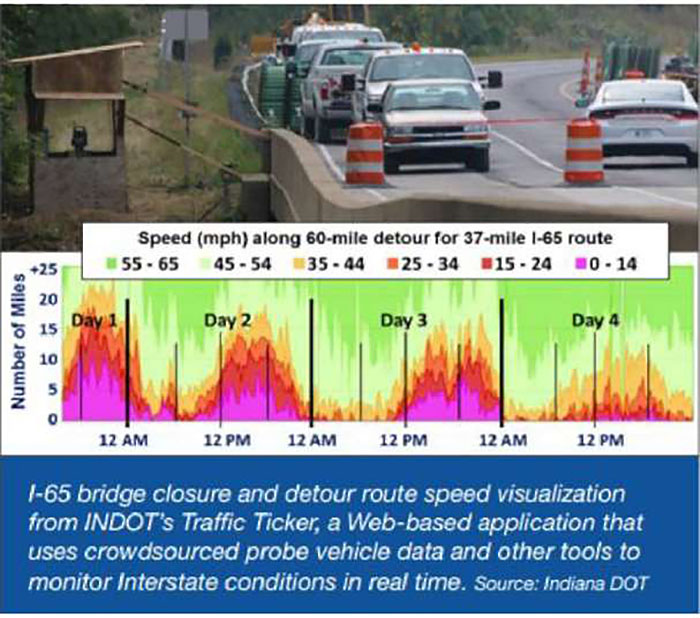
Crowdsourcing for Advancing Operations EDC-6 Factsheet (dot.gov)
Crowdsourced data from social media platforms, third-party data providers, and mobile applications can provide information on travel speed and time, traffic incidents, travel behavior, vehicular operation, and more. It can provide near real time data where there are no sensors or cameras. TMCs can integrate this data to more effectively manage the system and provide timely traveler information.
As shown above, Indiana DOT uses third-party probe data to actively manage major highways. The speed graphic is part of a dashboard created to support operational decision making, training, and after-action reviews.
Other FHWA crowdsourcing resources are available at the following sites:
Return to top ↑
ITS Overview
ITS applies information, technology, and systems engineering principles to the management and operations of surface transportation facilities and systems, including freeways, arterials, transit, and ports. It provides numerous benefits to transportation systems management and operations. ITS is an engineering discipline that encompasses the research, planning, design, integration, and deployment of systems and applications to manage traffic and transit, improve safety, provide environmental benefits, and maximize the efficiency of surface transportation systems. This field includes strategic planning; systems architecture; multimodal and multijurisdictional integration of technology, data, and communications interoperability; real-time data monitoring and decision-making support; and timely and accurate user information.
ITS stakeholders are multidisciplinary, representing a broad spectrum of user types and technical experts who work together to develop and constitute the ITS discipline. Each stakeholder brings perspective and knowledge to the profession, and this diversity is necessary to plan, develop, implement, manage, and maintain multimodal ITS. Civil, electrical, computer, data, and systems engineers; roadway and transit planners; logistics, policy, finance, and management experts; multimodal users; maintenance and operations professionals; public safety and emergency responders; and members of other disciplines that use and support transportation facilities and systems are all integral to the ITS discipline. Each stakeholder is part of a complex and collaborative team that envisions, deploys, and manages ITS.
Transportation systems include multiple modes (such as automobiles, transit, freight, bikes, and pedestrians) and facility types (such as highways, arterials, fixed guideways, dedicated bikeways, sidewalks, ports, and multimodal facilities). ITS has evolved to encompass programs, applications, and coordination across modes and facility types, thereby increasing system complexity and providing an opportunity to apply systems engineering to support multimodal ITS. The United States Department of Transportation (USDOT) ITS Joint Program Office (JPO) offers an overview of ITS applications and benefits in this video.
Integrated corridor management (ICM) is an example of a systems approach to transportation management that integrates freeways, parallel arterials, high-occupancy facilities, and transit services to optimize a network of facilities and services. This shift from individual facilities to networks and systems can be seen in Dallas, Texas, where ICM strategies in the Route 75 corridor, including combined route and mode diversion strategies for incidents, high-occupancy vehicle/high-occupancy toll strategies, smart parking systems for light rail transit, and advanced traveler information systems have been implemented. Oakland, California, is coordinating operations of existing I-880, arterials, rails, and bus transit networks through an integrated transportation system that balances real-time demand and supply. These ICM systems increase system capacity, reliability, and safety, while reducing congestion, fuel consumption, and vehicle emissions. The Federal Highway Administration (FHWA) posted a video in 2020 that makes the case for ICM.
Systems engineering provides a framework for the development and application of successful ITS systems. By focusing ITS on customer needs and required functionality, systems engineering integrates multiple disciplines in a structured development process that considers business and technical needs. Systems engineering has provided a foundation for ITS development, leading to the National ITS Reference Architecture that guides ITS from a concept of operations to application deployment.
Return to top ↑
Transportation Challenges
Over the past 40 years, the demand for the use of public roads has increased approximately 115 percent, as measured in vehicle miles traveled (VMT). Over this same time, the number of lane miles on public roads has increased 11 percent. These statistics indicate a sharp rise in demand while capacity—in terms of the number of lane miles—has stayed relatively constant. Although economics, changes in commuting patterns through flextime and telecommuting, and increasing availability of transit options have slowed the growth in VMT, vehicle miles traveled continue to grow. The graph below shows the percentage of increase in VMT over a 40-year period and the corresponding increase in capacity. To meet the increasing demand, transportation agencies must manage existing lane miles to maximize safety and efficiency. ITS offers a wide variety of management and operation tools to address increasing demand while enhancing safety and using technology to maximize facility throughput.
Trends in Capacity and Demandi
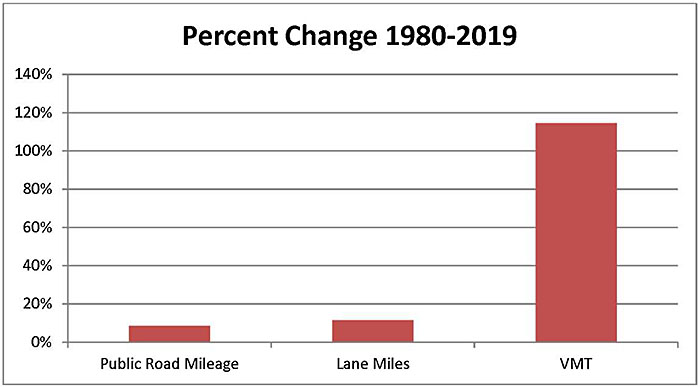
Source: FHWA Highway Statistics 2019.
Although funding for highways and public transportation has increased every 10 years from 1980 to 2019, limited funding and increasing pressure to do more with less at the beginning of the 21st century have significantly reduced the funding available for highways and public transportation through the U.S. Highway Trust Fund. This reduced funding, seen in the graph below, also increases the need to improve the efficient operation of limited infrastructure and to find new and innovative ways to safely manage the existing transportation system. ITS technologies support operational strategies such as ATM and ICM to address congestion and system reliability.
Highway Trust Fund Expenditures (in billions)ii
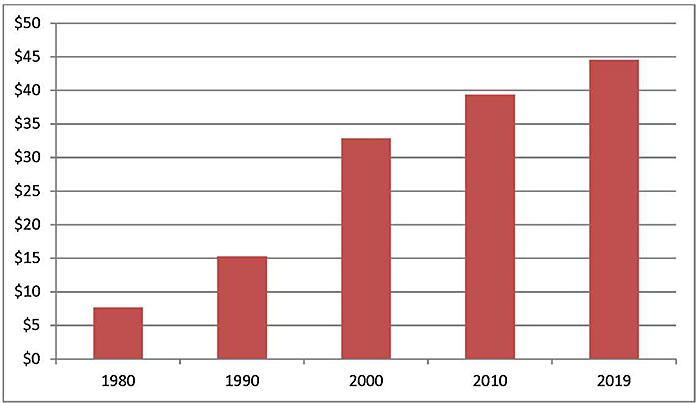
Source: FHWA Highway Statistics 2010 and ENO Center for Transportation.
Public transportation ridership increased in the first two decades of the 21st century, providing opportunities to move more people within the current and expanded infrastructure. According to the American Public Transit Association (APTA), nearly 60 percent of public transportation trips are commuter trips, and as employment increases, so too does the number of transit trips. Approximately 827 million trips were taken on public transportation per month in the United States in 2019.iii This number includes riders of heavy rail, light rail, and buses. ITS addresses this transportation challenge by managing transit systems and roadways to enhance transit mobility and integrate public transportation and highway facilities. In the past two decades, traveler information, transit prioritization, electronic fare collection, shared data, and integrated operations support increased ridership, system safety, and efficiency.
Workforce Needs
As ITS evolves and expands its role in the transportation field, the workforce needs to change to meet increasing reliance on technology and data analytics. Knowledge, skills, and abilities (KSAs) needed to support ITS deployment and expansion is an ongoing challenge in transportation organizations. Recent work by the National Cooperative Highway Research Program (NCHRP) and the National Operations Center of Excellence (NOCoE) has focused on the challenges facing transportation systems management and operations (TSMO) in general, including specific KSAs and workforce development needs for ITS. The NCHRP Project 20-07 Transportation Systems Management and Operations (TSMO) Workforce Guidebook, developed for the Transportation Research Board (TRB) of The National Academies of Sciences, Engineering and Medicine in 2019, provides guidance on recruiting, developing, and retaining a TSMO professional workforce. It also provides sample position descriptions for new and emerging positions and catalogs of educational resources.
The NOCoE conducted workforce summits in 2016 and 2021 to address the challenges of meeting developing a workforce for today’s transportation operations’ needs. Information on both summits can be found on the NOCoE website at transportationops.org.
Return to top ↑
Benefits of ITS
ITS applications that improve safety, mobility, reliability, and the environment, combined with traveler information and system demand management, enhance travel options and livability while minimizing costs to system owners, operators, and users. ITS technologies offer a wide variety of benefits for personal and public transportation, such as making trip scheduling and mode selection easier and providing public safety improvements by managing transportation systems during incidents, emergencies, and natural disasters.
ITS provides the technologies, tools, and applications to improve the capacity, reliability, and safety of surface transportation systems. The main purpose of ITS is to enhance system efficiency and safety. System efficiency supports the larger economy and environment while minimizing costs to system owners, managers, and users. ITS benefits transportation system users by reducing travel time and cost, simplifying toll and fare collection, and enhancing safety. Commercial carriers save time and money with electronic screening, timely route information, and port and terminal management.
The 2019 ITS Deployment Evaluation Executive Briefing looked at ITS benefits, costs, and lessons learned in the ITS Knowledge Resources databases and summarized the benefits and costs across 15 application areas. Executive briefings were developed for each of these application areas. Benefits of these applications include the following:
- Improved safety
- Reduced congestion
- Reduced emissions
- Reduced travel times
- Enhanced access and quality of life
- Crash prevention
- Cost savings for commercial vehicle operations
- Enhanced travel options
Safety is a significant goal of transportation policy served by ITS programs and applications. ITS technology directly addresses safety through current and emerging programs such as ATDM, traffic incident management, emergency traffic operations, and connected vehicle applications. ITS also provides increasing capabilities to monitor conditions, manage traffic in real time, and develop data-driven programs to enhance safety. Many of these applications have been implemented and have evolved since the emergence of ITS in transportation operations. These applications, along with other safety initiatives such as enhanced vehicle and roadway design, seat belt usage, and drunk driving public education campaigns, have contributed to the reduction of roadway fatalities in the United States. Between 1988 and 2019, the number of fatal crashes went from 42,130 to 33,244, despite significant increases in the number of vehicle miles traveled. (NHTSA, Traffic Safety Facts 2019)
ITS applications also benefit the transportation system by addressing specific challenges in system management and operations. For example, road weather management addresses challenges associated with adverse weather conditions using advisory, control, and treatment strategies. These applications monitor and inform motorists of adverse conditions, regulate motorist behavior to improve safety, and actively maintain roads to minimize weather effects. USDOT developed a library of best practices for road weather management, available at http://www.ops.fhwa.dot.gov/weather/mitigating impacts/best practices.htm, which presents state and local practices and case studies from around the country. The benefits of road weather management include better traveler information, more effective use of agency staff and resources, reduced incident response time, and improved planning for traffic management and weather events.
Ramp Metering Benefits
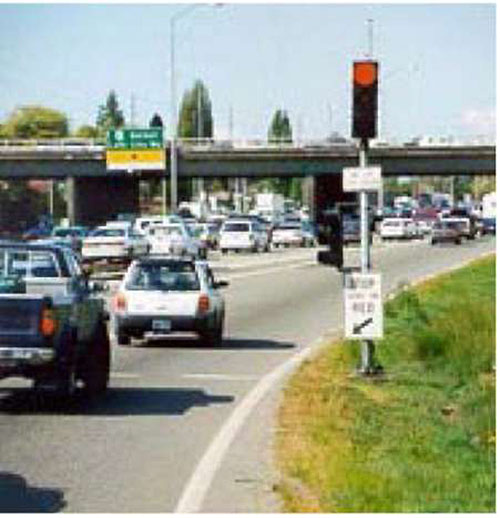
Source: WSDOT
Washington State Department of Transportation (WSDOT) implemented ramp meters on I-5 between Lacy and Lakewood in 2015. The before and after study showed improvements in throughput and reduced travel times. The ramp meters created timed gaps between vehicles entering the freeway to allow safer and more efficient merging. This improved operations for the entire corridor by balancing the demand of vehicles and entering and traveling on the interstate, reducing delay by as much as 60 minutes and increasing speeds by 5 to 20 miles per hour.
US.DOT 2019 Urban Congestion Trends
ITS enhances safety, improves mobility, and protects the environment through applications such as electronic toll collection. Applying ITS to managed lanes allows for the deployment of variable pricing programs to manage congested freeway corridors. The technology that automates tolled express lanes can separate express traffic from general-purpose lanes and maintain free-flow conditions. The system has been found to increase the value of express lanes by more than 50 percent compared to carpool lanes, largely by saving significant travel time. For example, USDOT ITS JPO estimates that electronic tolling provides over $1 billion per year in savings. Additional information is available on the USDOT ITS JPO site.
Another benefit comes from red light cameras, which detect red light violations at signalized intersections. By generating citations for vehicle violations, the technology is estimated to provide $1 billion in safety-related benefits by reducing injuries and fatalities as well as damage to property. ITS applications that improve vehicle operations and reduce congestion have positive implications for fuel consumption and vehicle emissions, minimizing environmental impacts from transportation sources.iv
Return to top ↑
History of ITS
Management and operation of surface transportation systems focused on safety and efficiency can be traced back to the mid-20th century when roadway planners began to address increasing commuter travel and system congestion. During the 1980s and early 1990s, many of the technological advances in computing and communications enabled the development of applications that spawned modern ITS programs. In 1984, Los Angeles deployed an automated traffic surveillance and control systems that integrated vehicle detectors, CCTV, and coordinated signal timing data. In 1989, FHWA convened Mobility 2000, a working group focused on developing a national program of automated technology. The group brought together public, private, and academic representatives to explore and promote the application of advanced technologies on highways to improve safety and efficiency.
The 1991 Intermodal Surface Transportation Efficiency Act (ISTEA) and subsequent reauthorization encouraged new technologies to improve safety, information exchange, system capacity, and travel times. These initiatives spawned the development of transportation technology applications that form the foundation of the modern ITS program in the United States. ISTEA also required the development of standards and protocols to promote compatibility among the technologies that were being deployed by state and local agencies. The initial development of a national architecture began in the mid-1990s, with the involvement of multidisciplinary public, private, and academic teams, and provided the foundation for current ITS national and regional architectures.
The term intelligent transportation systems emerged in the late 1990s to include a more multimodal focus. The USDOT’s ITS program is structured to meet a wide variety of user needs through ITS strategies and technologies. Advances in ITS development include expanded multimodal applications such as transit operations, intermodal and commercial vehicle operations, and integrated traveler information. These applications support a systems approach to surface transportation that allows the sharing of information and ITS infrastructure across multiple modes of transportation.
The first decade of the 21st century brought an increased focus on intelligent vehicles to enhance safety, operations, and the environment through enhanced communication and vehicle-based applications and technologies, including collision avoidance, driver assistance, and collision notification. These applications, developed in partnership with vehicle manufacturers, offered opportunities to expand ITS capabilities with minimal infrastructure costs. This evolution to a system of connected vehicles will reduce the need to invest in large, centralized infrastructure-based systems while supporting and expanding system capabilities.
The 2012 surface transportation funding legislation, Moving Ahead for Progress in the 21st Century (MAP-21), transformed the policy and programmatic framework for investments in transportation, created a streamlined and performance-based surface transportation program, and built on many of the highway, transit, bike, and pedestrian programs and policies established in 1991 with the passage of ISTEA. An excellent view of the ITS timeline is available USDOT website at HistoryITS Timeline.pdf.
An increased focus on performance measures and system management changed the role of ITS in two fundamental ways. First, ITS offers greater system efficiencies with potentially smaller investments than capacity-expanding infrastructure programs; therefore, a performance-based system may favor increased investments in the operational and safety capabilities offered through ITS. Second, ITS is built on the collection, exchange, and evaluation of management and operations data. This data is critical to any performance-based system. ITS infrastructure and personnel are uniquely positioned to support data-driven, performance-based policies and processes.
With the advancement of communications and data analytics, data can be shared over expanding networks between vehicles and between infrastructure and vehicles. Enhanced networks, Cloud technology, and data analysis support real-time operations, performance management, and traveler information. Connected vehicles and automated driving systems are changing the face of transportation with increased cooperation, efficiency, and safety. The US DOT publication History of Intelligent Transportation Systems, published in 2016, provides a detailed account of the history of ITS.
Return to top ↑
National ITS Reference Architecture
In the 1990s, as applications and deployment of the intelligent vehicle highway system became more extensive and complex, there was a need for a shared architecture to provide a framework for systems planning and operation that addressed compatibility, functionality, integration, and interoperability. Architecture development was initiated in 1994 and continues to evolve to meet the current needs of ITS. The National ITS Reference Architecture (ARC-IT) provides a common framework for planning, defining, and integrating ITS. The current version, ARC-IT 9.0, defines four architectural views, shown in the graphic below.
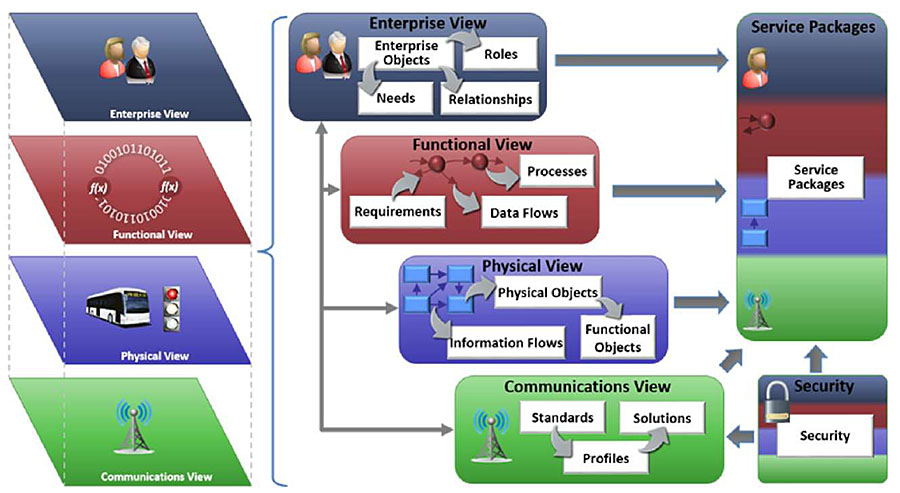
Source: USDOT
ARC-IT Version 9.0 includes the four views illustrated above—enterprise, functional, physical, and communications—as well as 150 service packages and use cases for transportation planning and project development. The service packages address specific services, including their functional objects and information flows. They are organized into the following areas:
- Commercial Vehicle Operations
- Data Management
- Maintenance and Construction
- Parking Management
- Public Safety
- Public Transportation
- Support
- Sustainable Travel
- Traffic Management
- Traveler Information
- Vehicle Safety
- Weather
In addition, security is addressed across all four views as a critical issue for ITS.
Regional Architecture
Whereas the National ITS Reference Architecture guides ITS programs at the national level and addresses all subsystems, technologies, and standards, regional ITS architectures define the plans, programs, goals, and objectives for implementation on a more localized basis. The
Regional Architecture Development for Intelligent Transportation (RAD-IT) Version 9.0, updated in 2021, supports transportation planners and systems integrators in the development of regional and project ITS architectures using ARC-IT.
Regional ITS architectures are developed to meet the specific needs of a region, define program goals, identify applicable standards, develop institutional agreements, and focus on the technical integration of ITS systems within the region. Regional architectures consist of functions within the ITS elements and the flow of information to connect the elements within the region.
National ITS Standards
The USDOT ITS Standards Program, established in 1996, focuses on interfaces and information exchanges identified in the National ITS Reference Architecture to ensure that development and implementation of the system and system components by federal, state, and local agencies, as well as private sector developers and vendors, maintain technological compatibility and functional communications. Standards development is supported by the ITS Standards Program of USDOT’s ITS JPO and provides a collaborative process to define and update standards for use by all public and private entities involved in the development of ITS applications and technology. The ITS Standards Program works with standards development organizations, such as the American Association of State Highway and Transportation Officials (AASHTO), the Institute of Transportation Engineers (ITE), the American Public Transportation Association (APTA), and the Institute of Electrical and Electronics Engineers (IEEE), to address interface requirements between different ITS applications.
ITS standards provide the technical guidance and requirements for each component of an ITS system. They guide every aspect of technical applications and system communications, and compliance is required for all applications. The collaboration between a broad range of stakeholders to develop the ITS standards continues through standards management and professional capacity building. As part of its Standards Implementation Assistance program, the ITS JPO offers technical assistance, guidance, and training. Initiatives include a web-based, modular ITS Standards training series, available at standardstraining/, as part of a larger ITS Professional Capacity Building Program.
The relationship between the National ITS Reference Architecture, Regional ITS Architecture, ITS Standards, and project architecture is shown in the graphic below.
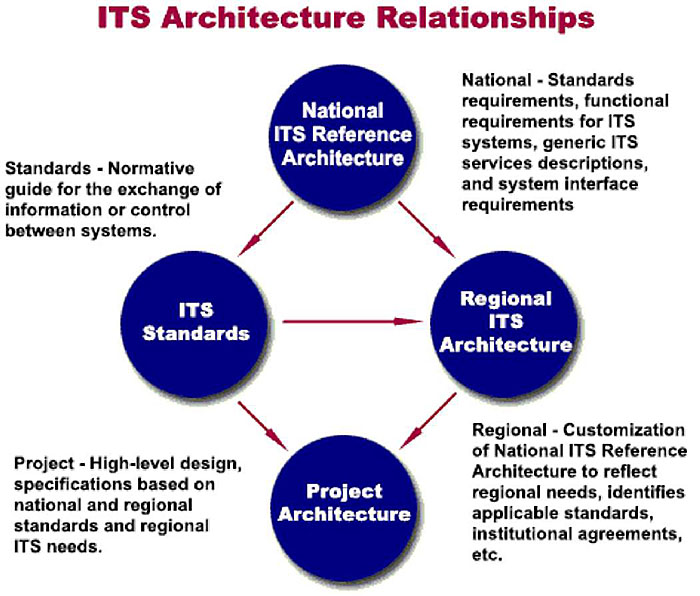
Source: USDOT
Return to top ↑
Growth of ITS Deployment
ITS deployment and market share are rapidly growing globally and nationally. According to a market research report published by Grandview Research, the global value of the ITS market was estimated at over $26 billion in 2021, with a projected growth rate of 7 percent from 2021 to 2028, expected to reach $42 billion by 2028. North America currently dominates the ITS market with almost 43 percent of the market in 2020. This is attributed to USDOT investments in research and development, adoption, and deployment efforts. The report notes that advanced traffic management systems (ATMS) accounted for over 30 percent of the market share, and that advanced public transportation system (APTS) is a segment anticipated to show considerable growth over the 2021-2028 forecast period. A study by Global Market Insights found that the ITS market exceeded $40 billion globally. The ITS market is projected to have a growth of 9 percent compound annual growth rate globally and 12 percent for the U.S. market. (Intelligent Transportation System Market Size Forecasts 2027 (gminsights.com))
The USDOT ITS JPO published Deployment of Intelligent Transportation Systems: A Summary of the 2016 National Survey Results in March 2018. The tracking survey has been conducted since 1998. The survey targets 108 metropolitan areas and included 849 state and local agencies in the 2016 survey. The survey documented ITS deployment trends in freeway management, arterial management, incident management, transit management, and future deployment plans.
Freeway Management
The survey found an upward trend continued in the coverage of surveillance on freeways, with three quarters of freeway miles covered by electronic surveillance for monitoring traffic and more than two thirds of miles covered by closed circuit television (CCTV) cameras. Other freeway monitoring deployments included the use of radar, in use by 62 percent of freeway agencies; loop detectors used by a third of agencies; probe readers, such as Bluetooth, increasing significantly from 24 percent in 2010 to 52 percent in 2016. Dynamic message signs (DMS) deployment continues to increase, with over 6,000 DMS in national use.
Arterial Management
The survey found increased adoption of ITS deployments by arterial agencies. Electronic surveillance systems by arterial agencies increased significantly with the coverage of signalized intersections increasing from less than 50 percent in 2010 to three quarters in 2016. More than three quarters of the arterial agencies reported the use of video imaging detectors, up from 58 percent in 2010. Bluetooth stations were in use by 39 percent of arterial agencies, three times the number reported in 2010. Deployment of traffic adaptive signals increased significantly from 23 percent of agencies, up from only 2 percent in 2010.
Incident Management
Technologies that support detection, response, and management of incidents also increased between the 2010 and 2016 surveys. This includes the increased deployment of CCTV from 46 percent to 68 percent freeway coverage, service patrol coverage covering 56 percent of reported freeways, up from 48 percent in 2010; and arterial coverage of CCTV and service patrol, reported at 20 percent and 16 percent respectively.
Transit Management
ITS technologies deployed in transit management include automatic vehicle location (AVL) systems, electronic fare payment, and signal priority for transit vehicles. The use of AVL on fixed route buses increased to 76 percent of transit agencies, up from 54 percent in 2010. Transit agencies reported electronic fare payment with magnetic stripe readers in use by 57 percent of agencies, and smart card readers in use by 42 percent. There was little increase in the adoption of signal priority systems by transit agencies, remaining at 26 percent.
Return to top ↑
Future Vision for ITS
In March 2020, the USDOT ITS JPO released its Strategic Plan 2020-2025. The plan looks at the vision and research goals to guide ITS JPO research and development in technology priorities.
The ITS JPO’s vision is to accelerate the use of ITS to transform the way society moves… The ITS JPO envisions a future in which citizens and communities can enjoy safe and seamlessly integrated transportation services, and where on-demand and realtime user and data needs are met by a wirelessly interconnected transportation ecosystem. that offers intelligent feedback loops for continual system improvements.
As infrastructure and vehicles become smarter and better connected, as Cloud computing, Edge computing, and data availability and analytics evolve and expand; and as public acceptance of new technologies to enhance traveler information, safety, and system performance increases, ITS will provide the framework and technology to integrate and operate the nation’s transportation systems. The technology-based nature of ITS makes it a dynamic field with limitless potential, both in terms of leading and supporting innovative applications in the public and private sectors.
The graphic below illustrates the primary area of strategic focus for USDOT ITS JPO outlined in its Strategic Plan 2020-2025.
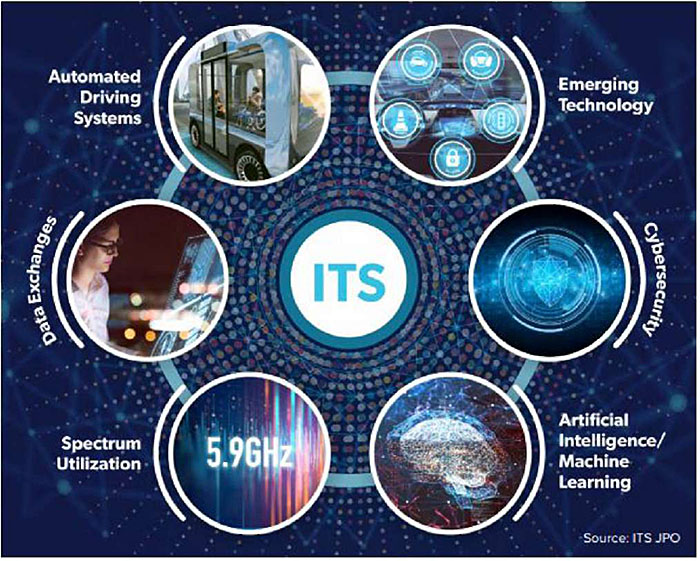
Source: USDOT
USDOT ITS JPO Strategic Plan 2020-2025 identified research areas, as shown below. The Strategic Plan goals, these research areas, and technology transfer programs work together to accelerate ITS deployment.
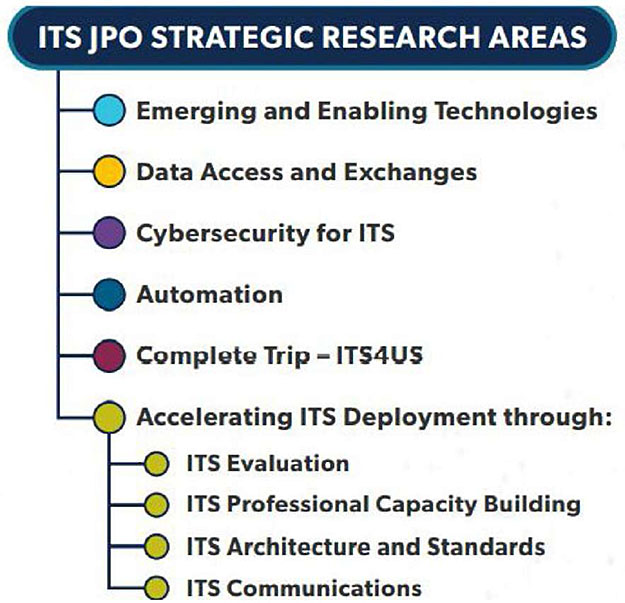
Source: USDOT
Return to top ↑
ePrimer Overview
The ITS industry is an expanding market for information, engineering, and technology professionals. A recent article by ITS International estimates the current ITS workforce at 14.8 million. This ITS ePrimer introduces the expanding field of ITS to students and professionals and addresses ways to integrate it with the practical applications of transportation engineering in the field of surface transportation management and operations. To support changing transportation and environmental needs and system challenges, the ePrimer considers systems engineering, multimodal applications, institutional and policy issues, and new and emerging technologies. ITS provides an array of technical and systems management applications to maximize system management and operations.
The original ePrimer was developed in 2013 to provide an introductory overview of a wide range of multimodal ITS topics. A project management team composed of the US.DOT ITS JPO, the FHWA Office of Operations, the Federal Transit Administration, the Institute of Transportation Engineers, and ITS America led the development of the primer and the selection of module authors. Updates were made to a number of modules in 2016, and new modules were added in 2019 and 2021. Updates to this module and two others were made in 2021.
The ePrimer is organized in a series of modules that address key ITS concepts and applications. The modules were written by a team of ITS practitioners, and each focuses on a specific aspect of ITS. The individual authors were selected as subject matter experts, and each brings his or her experience, perspective, and approach to the module topics. For that reason, the modules vary somewhat in level of detail, depth of discussion, and writing style. It is hoped that these differences enhance the overall product and reflect the authors’ experience.
Each module provides specific learning objectives, an introduction to the module topic, and topical discussions developed to introduce ITS to university students and transportation professionals. The modules incorporate multimedia resources that provide topic-related examples, training materials, case studies, or other linked media. This current module provides an introduction to ITS and an overview of the ITS ePrimer. Subsequent modules of the ePrimer present various aspects and applications of ITS in managing surface transportation systems. The following is a brief description of the modules:
Module 2. Systems Engineering
Systems engineering is used to develop ITS projects in an interdisciplinary, structured process that meets the needs of the users, providers, and other stakeholders while it maintains the schedule and budget. This module provides an overview of systems engineering and its application to ITS architecture, planning, and deployment.
Module 3. Application of ITS in TSMO
Transportation systems management and operations (TSMO) is a coordinated approach to managing and operating surface transportation systems. This module looks at the role of ITS in TSMO and provides an overview of ITS technology and tools used to manage transportation strategies, systems, and networks. This module was added in 2021.
Module 4. ITS Data in Decision Making
This module explores the use of data available through ITS technology for decisions made to operate transportation systems. It introduces fundamentals related to collecting, storing, analyzing, and sharing ITS data to manage performance and improve decision making. This module was added in 2021.
Module 5. ITS to Support Travelers
ITS technologies offer an array of applications and enhancements for multimodal transportation, from real-time information to safety applications and traveler conveniences. This module explores current and emerging applications that enhance traveler experience and safety. This module was updated in 2021.
Module 6. Freight, Intermodal, and Commercial Vehicle Operations ITS applications in commercial fleets and intermodal and freight movement address safety, security, efficiency, and driver services. This module highlights various ITS applications used in commercial vehicles and freight management. This module was updated in 2021.
Module 7. Public Transportation
ITS offers a broad range of applications to enhance efficiency, convenience, safety, and security in public transportation and transit systems management. This module discusses system and fleet management, advanced traveler information, and safety and security applications in transit and public transportation. It identifies ways in which ITS can be integral to achieving multimodalism, facilitating round trips from origin to destination, and trip linking.
Module 8. Electronic Tolling and Pricing
ITS technologies play a significant role in facility pricing and collection applications, including multimodal, highway, and transit applications. Pricing and collection systems provide the technological foundation for user fees and managed facilities. This module considers both the application and integration challenges and technologies available.
Module 9. Supporting ITS Technologies
Data collection, weather and traffic monitoring, communication, and in-vehicle systems are all essential supporting technologies for effective ITS. Advances in technology and integration provide opportunities for system enhancement. This module provides an overview of various support technologies and considers opportunities for deployment and integration.
Module 10. Rural and Regional ITS Applications
The application of ITS in different geographic, jurisdictional, and land use contexts presents unique challenges and opportunities to ITS professionals. This module considers varying contexts, from rural applications to large, multistate, multimodal programs.
Module 11. Sustainable Transportation
ITS technologies can support a number of sustainable transportation initiatives, including monitoring, evaluating, and enhancing system efficiency and sustainable transportation programs. This module explores opportunities to integrate ITS technologies in support of sustainable transportation.
Module 12. Institutional Issues
ITS institutional issues are as complex and challenging as technological issues. Public concerns with personal privacy and political and organizational challenges with funding, system ownership, and legal requirements need to be addressed effectively to deploy ITS on a consistent and systematic basis. This module looks at several of these issues and provides guidance on addressing institutional concerns and opportunities.
Module 13. Port Operations
This module, added in 2019, provides an overview of ITS technology related to port operations. The module is intended to facilitate the expansion of U.S. port participation in the development, implementation, and operations of ITS projects regionally and in a port environment. It discusses the key elements involved in planning, evaluating, financing, and deploying ITS projects that can address congestion and other transportation network challenges experienced by ports.
Module 14. Connected Vehicles
Connected vehicles offer a fundamental change in systems management and ITS infrastructure by focusing on vehicle-to-vehicle and vehicle-to-roadway communication. This module looks at the current and emerging technology and the institutional, policy, legal, and funding challenges of connected vehicle applications. This module was updated in 2021.
Module 15. ITS in Emergencies and Disasters
The purpose of this module is to provide basic information on how ITS can support transportation operations during emergencies and disasters. It looks at operational resilience, emergency transportation operations (ETO), and traffic incident management (TIM), as they relate to ITS. ETO and TIM are fundamental functions of TSMO, and ITS is instrumental in delivering ETO and TIM services. The module introduces ETO and TIM and discusses how they support transportation operational resilience. This module was added in 2021.
Module 16. ITS Emerging Opportunities and Challenges
This module looks at how the rapid developments in data, computing, and telecommunications are changing fundamental assumptions in transportation demand, supply, and operational management, and why it is important that transportation professionals involved in ITS not only keep up with those developments but take active roles in ensuring that ITS use cases are anticipated and properly defined, engineered, and implemented. Transportation professionals have a truly unique opportunity to leverage new technologies to innovate smarter, more resilient, and sustainable transportation systems for the future. This module was updated in 2021.
Although the 16 modules are structured around specific topic areas, some applications, technologies, and other considerations cut across two or more topics. Each module is designed to stand on its own, so some information may be discussed in more than one module, with an orientation or focus on the module topic.
i FHWA Highway Statistics 2019. Highway Statistics 2019 - Policy | Federal Highway Administration.
ii FHWA Highway Statistics 201., Highway Statistics 2019 - Policy | Federal Highway Administration.
iii APTA Statistical Reports. Ridership Report - American Public Transportation Association.
iv USDOT JPO Benefits for Intelligent Transportation Systems (ITS). http://www.its.dot.gov/factsheets/pdf/Benefits FactSheet.pdf.
Return to top ↑